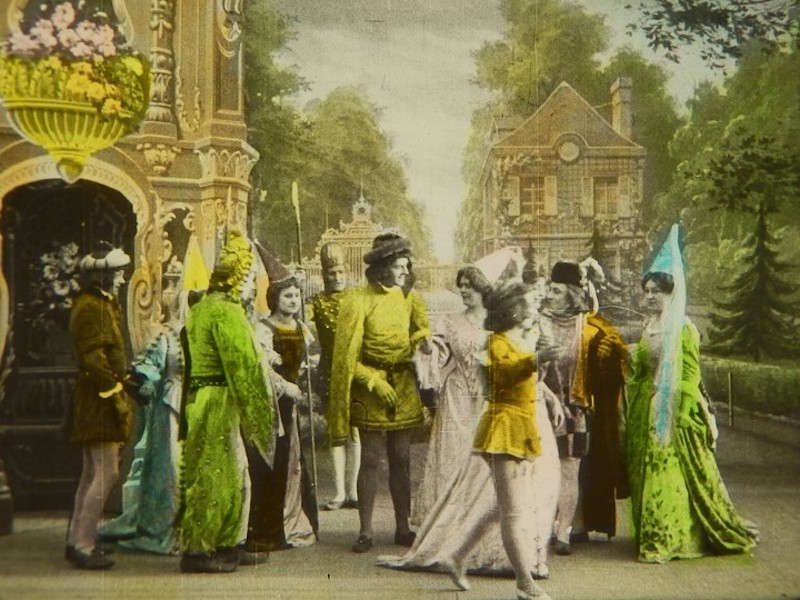L’AMOUR ET L’ARGENT
(US: Love and Fortune)
? (FR 1908)
In a deserted town square, in the abstracted atmosphere of some Mediaeval fantasy, the flower-girl Graziella awaits the arrival of her beloved Ascanio. But he – in disguise, graceful in appearance but proud in character – wants nothing of it: he aspires to a life of riches and a woman covered in jewels, not the flower garland made by the girl next door. His wish comes true through a good-luck fairy, but, as the saying attributed to Oscar Wilde warns, we must be careful what we wish for, because we might get it. For if those desires come true undeservedly, it would alienate the sympathy of both gods and fairies.
L’amour et l’argent is an edifying fable, coloured with dazzling stencil technique, which (as was often the case in those days) points a finger at the putative dangers of social mobility – a story seen at the time as capable of successfully combining “an element of magic with stern realities” (Moving Picture World, July 1908). It was created by the young but obviously ambitious French production company Lux Film, founded just two years before by the pioneer Henri Joly. If we pay attention, it’s not hard to recognize its trademark – the Statue of Liberty – embedded in the richly decorated interiors.
The copy presented here is a preserved nitrate print with Italian intertitles, identified by Eric Loné in 2018. The Bibliothèque Nationale de France has a screenplay divided into 15 tableaux, with small gaps in the copy and probable afterthoughts made during shooting: for example, the ending, which is here reduced to a hasty reunion because of a cut at the end of the reel, actually took its time to show the wedded bliss of the reunited and prolific couple (Please forgive this small, predictable spoiler).
“C’est dans la médiocrité que se trouve le vrai bonheur” (“True happiness is only found in mediocrity”), however, is a maxim that might be good as a moral warning but certainly not as a description of form. From the chromatic point of view the film, despite some deterioration, is dazzling for its richness of colours, the symbolic finesse in the use of those colours, and the elegance of tonal combinations. Dark reds, bright greens, and deep midnight blue are never chosen at random: the popular settings are rendered with earth tones, and especially with sophisticated shades of brown, against which the characters stand out like sculptures. The contrast with the brilliant luminosity (as bright as gold!) of the palette used to represent the palace and its residents offers a symbolic foil which couldn’t be more effective. The film was released in the United States with the title Love and Fortune, in a version which sought to mellow the character of the male protagonist, at least judging by the synopses in the period press: the American Ascanio was always in love with Graziella, and he only lets himself think of wealth in his dreams.
Stella Dagna


regia/dir: ?.
cast: ?.
prod: Lux Film.
copia/copy: 35mm, 170 m. (orig. 228 m.), 9′ (16 fps), col. (pochoir/stencil-colour); did./titles: ITA.
fonte/copia: Museo Nazionale del Cinema, Torino.




